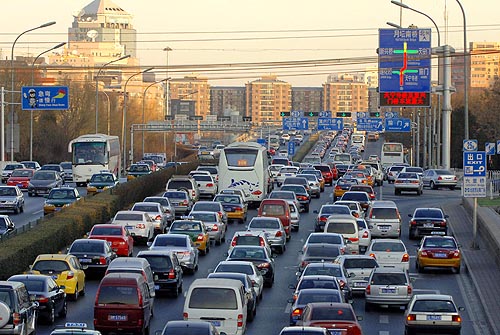|
 |
|
RUNNING OR PARKING: Gridlock grips Beijing's West Second Ring Road on December 18. The number of motor vehicles in the city surpassed 4 million that day (GONG LEI) |
Beijing, the city once known as the kingdom of bicycles, has become clogged with automobiles, the Beijing Municipal Government Publicity Office said on December 18.
Beijing authorities had registered 4,001,426 vehicles in total by December 18. About 2,000 new cars are being sold daily, they said.
The number of cars in Beijing has exploded over the past decade.
"Compared with other metropolises around the world, the growth of vehicles in Beijing is dramatic," said Guo Jifu, Director of the Beijing Municipal Communication Research Center.
It took six years for the number of cars on the city's streets to rise from 1 million to 2 million in 2003. It only took another four years for the number to reach 3 million in 2007. The next million cars flooded the roads in just two years, Guo said.
Chen Yao, a senior researcher of industrial layout and regional economy at the Chinese Academy of Social Sciences, said if the number of automobiles keeps growing by more than 1,000 per day, it would take just five years for the total to swell to 8 million.
Traffic congestion
The rapidly rising number of cars has almost offset the positive impacts of traffic control measures taken by the government, which implemented drive-time restrictions on cars based on the last digit of their license plate numbers. The initiative took 20 percent of cars off the roads every day beginning on October 11, 2008.
"If the government does not plan in advance, the traffic in Beijing will be clogged and people will come to blows," Chen said.
The number of major thoroughfares where speeds have decreased to less than 20 km per hour has recently risen to 70 during the morning peak, according to the Beijing Municipal Transportation Administration Bureau's command center.
"More than 90 percent of Beijing's roads are overloaded. The growth of road construction is much slower than that of vehicles," said Zhang Jingchun, head of the bureau's information office.
By the end of 2007, there were 4,460 km of roads operating in Beijing, about 2.5 times more than there were in 1978, official statistics show.
The city now plans to add 280 km to its express road network in the next five years to ease traffic, according to Xinhua News Agency.
But to add to the problem, a lack of parking spaces in the city's downtown and residential areas has also become a headache for new car owners.
"All the new cars will need another 60 square km of parking space, which equals the total area within the Second Ring Road," Guo said. "We need to come up with new administrative and legislative measures to restrict new car growth."
He said Beijing must introduce more bus-only lanes to encourage residents to use public transport during rush hours.
Thirteen new subway lines are under construction in addition to the six that are already operating. By 2015, the city's subway lines will stretch 561 km.
Air pollution
Despite the city's success in slashing the number of heavy pollution days this year, Beijing faces a mounting environmental burden because of ever increasing traffic congestion, air pollution specialists warn.
Zhu Tong, an environmental professor at Peking University, said it is too early to reach positive conclusions about Beijing's air quality.
"Beijing's air looks to be improving from official data after the Olympics," said Zhu. "But research should also be conducted to assess how increased congestion from the growing army of cars has contributed to emissions and air pollution."
It is estimated that the 4 million cars will produce 1 million tons of pollutants each year and will account for half of the city's total emissions.
In order to ease air pollution, Beijing is continuing to encourage people to take the public transport system.
About 13.6 million passengers use Beijing's public transit every day, amounting to more than 4.8 billion people this year. Ridership is up 11.1 percent from last year, according to the Beijing Public Transport Group.
"Apart from improving public transport efficiency, switching to zero-emission vehicles should be the ultimate goal for all drivers in Beijing," said Zhu.
The Beijing Municipal Commission of Development and Reform announced new plans to add 500 electric taxis by the end of next year. Though that is less than 1 percent of the city's total taxi population, the commission said the technology would be deployed in 20,000 buses and cleaning vehicles in the coming years.
Beijing has removed more than 100,000 vehicles that are the most polluting from streets this year, the Beijing Municipal Bureau of Environmental Protection said.
"This contributes to a reduction of 25 percent of total car emissions in Beijing," said Li Kunsheng, head of the bureau's vehicle emission management division.
Li Xin, a researcher with the Beijing Municipal Communication Research Center, said the city also plans to ban 357,000 "yellow label" vehicles from entering the Fifth Ring Road to improve the city's air quality beginning on January 1. Vehicles in Beijing are issued either green or yellow labels according to their emission levels. Those with yellow labels—mostly affixed to dump trucks and other heavy-duty vehicles—are banned from entering the city center during the day. By October next year, they will be completely banned in Beijing, he said.
Li said tax exemption policies would be introduced next year to encourage the development of electric vehicles, as well as those that use mixed energy and those that produce lower emissions. | 